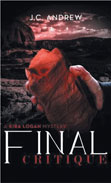
 |
Kira Logan only wants to escape Phoenix's summer heat and relax a little. Between classes, she signs up to teach for a week at the charmingly bucolic Hidden Canyon Art School in northern Arizona. Unfortunately, Kira finds herself playing reluctant amateur detective yet again. What, if anything, does the suicide of a broody young Christian fundamentalist among her students have to do with a suspicious incident that severely injures a young woman—Julie Williams? Is Julie's mishap at all related to an overwhelming desire among her fellow students for revenge against her brother Jason? Many believe he was insufficiently punished for a drunk driving crash that ruined one life and ended another. Or did Julie fall foul of a scorned woman?
Though most class members know each other, they are all strangers to Kira and are as full of personal and artistic potential as the blank canvas on which Kira renders her commercially successful oil paintings. She won't form an opinion of the troubled Williams siblings based on Jason's long-past misdeeds or Julie's previous romantic escapades. Judgmental Helen Unger, jilted Diane Benton, and grief-stricken Marcie Spears are busy enough reminding Jason and Julie of the misery they've caused. But are any of them murderously inclined? As hatred for the brother and sister grows, Kira wonders where to draw the line between annoying practical jokes and vindictive endangerments aimed at them. The desert is no longer the starkly beautiful respite Kira sought. Who among them would put two people at deadly risk?
The characters are presented as unknown quantities to Kira, but readers are given a brief backstory of each one as they arrive at the art center. This contrast between known and unknown presents a view of humans as works of art in progress. Kira sees opportunities to influence both her students' oil painting and their worldviews as they each grapple with Jason's mistakes. She often observes that a student's painting style reflects the person's frame of mind. Students in dark moods paint shadowy pictures, while confident students paint bold lines with freer brush strokes, for example. Sometimes, scenic and situational descriptions slow the narrative's progress, but the resulting deeper understanding of the characters' motivations more than compensates for this. Explanations of the uses for the artists' various supplies provide informative context for those unfamiliar with the art world.
Andrew is the author of three other Kira Logan mysteries. In this installment, her enthusiasm for watercolor and oil painting, two art forms which she herself creates, is abundantly apparent, as is her appreciation of Arizona's varied landscape. Kira's success as an artist mirrors Andrew's own, as the author has received many awards for her work. This book can proudly take its place among novels about art. Like B.A. Shapiro's The Art Forger and The Collector's Apprentice, this is a mystery that features a woman with a strong artistic bent. Unlike the other protagonists, though, Kira enjoys a position of authority as a teacher. Readers interested in the art world and fans of amateur sleuths may find much to enjoy in this book.